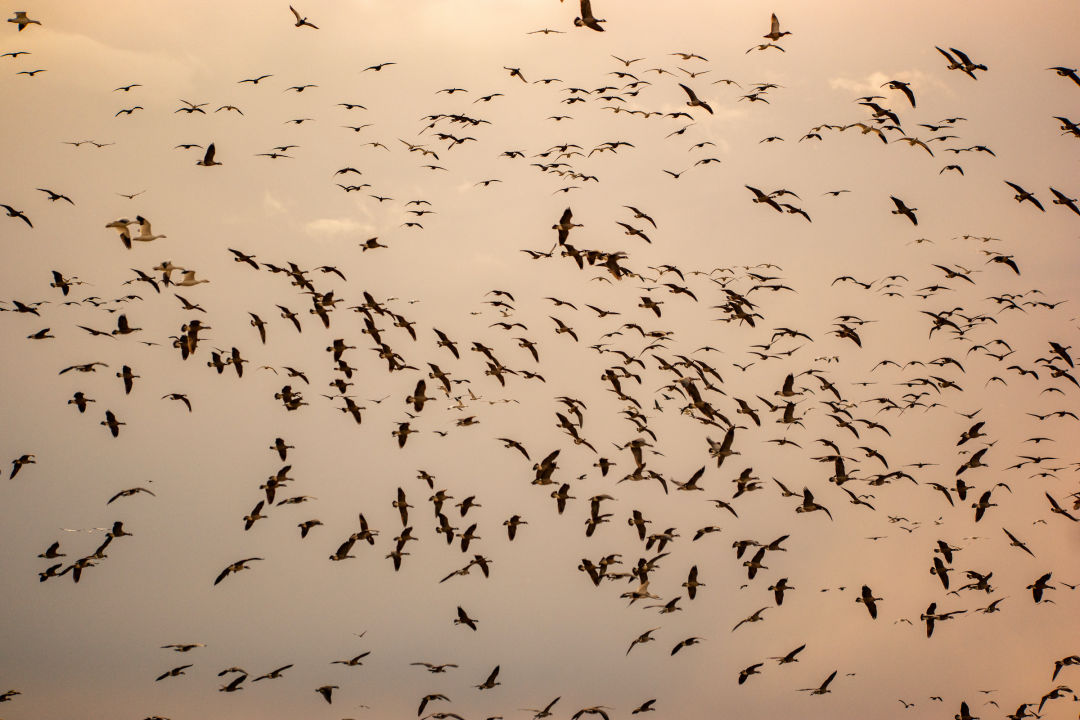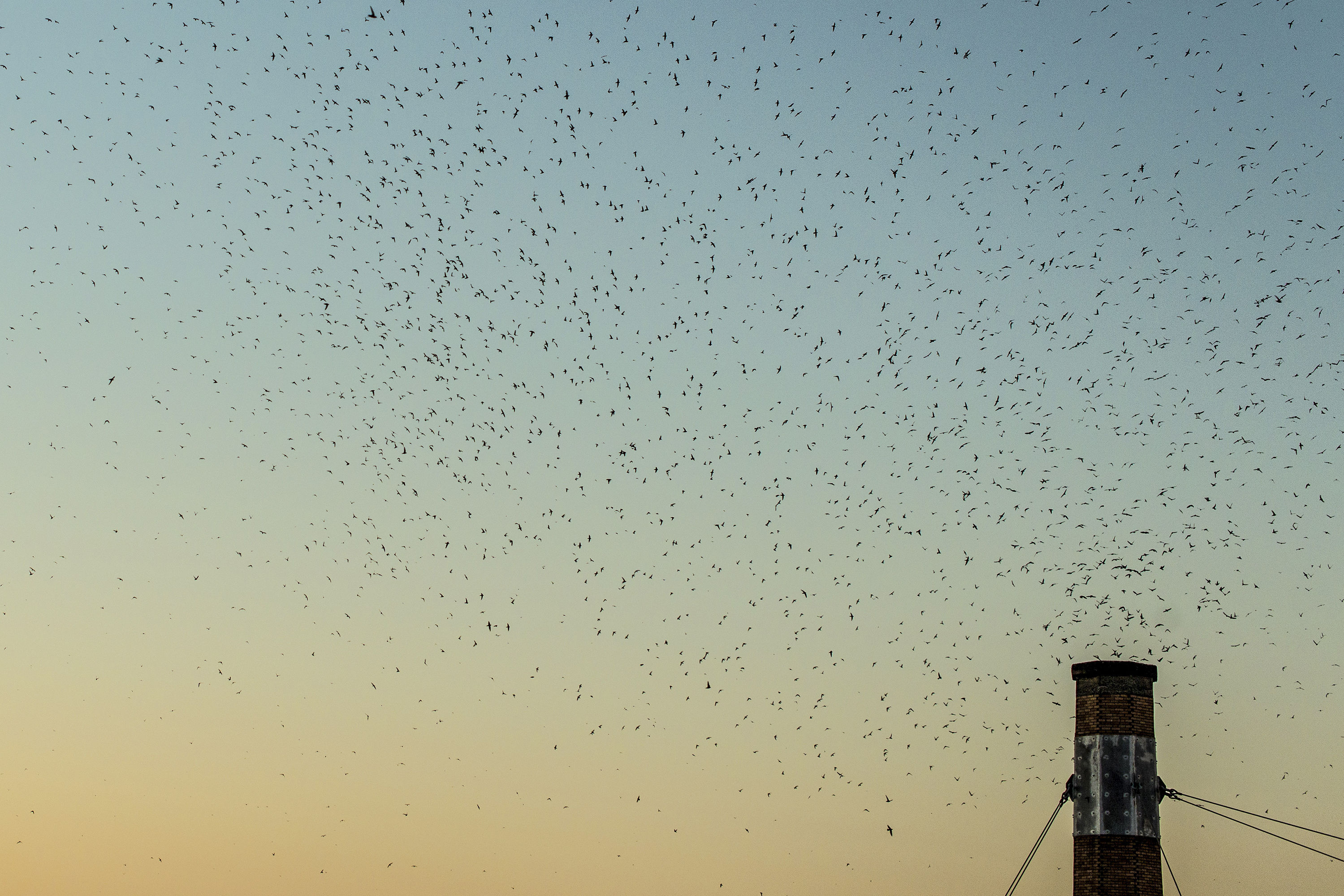Fall Bird Migrations in Oregon and Where to Watch Them

Sauvie Island migration
On a recent morning, Brodie Cass Talbott, an educator with Portland Audubon, went out to Broughton Beach just north of downtown. There he spotted what probably wouldn’t look like much to a non-birder, but to him it was exciting. It was a rare arctic gull that just happened to be migrating through the area.
It was small and inconspicuous, and very much unlike the huge spectacles we’ve come to expect when we think of birds in migration—the V-shaped gaggle of geese soaring through the sky, the Vaux’s swifts swirling by the thousands into the Chapman Elementary chimney.
“I think that sometimes migration can seem not as obvious as maybe we picture in our mind when we’re first learning about it…. A lot of these birds are flying at night, when they're not visible, and then are landing and foraging during the day, which can feel a little invisible to us,” Cass Talbott says. “I honestly think [it’s] just about looking up and listening.”
Fall, however, is a spectacular time for birding novices to seek out and begin to recognize our avian neighbors, even if they are here for only a moment. And we are in peak fall migration. Portland Audubon recently clocked in 5.3 million birds flying over Oregon.
For the uninitiated, Talbott recommends starting small—in your own backyard. Songbirds, he says, can turn up anywhere, and birders this time of year watch their backyards carefully to see if any unusual songbirds turn up. “I've had a Western Tanager in my yard for the last week,” Talbott says. “Local parks are also great to try and catch migrant warblers, like the Black-throated Gray Warbler I had in Woodlawn Park this morning.”
Birding, Cass Talbott says, is like anything else, a process by which you build on the foundation.
“Just start at the beginning, and appreciate the birds that are around you, the ones that you see and hear the most often. And then that leads [you] to wanting to know what’s out there, exploring different habitats, exploring different parts of the city and the state, and just letting you experience with birds drive what you’re searching as opposed to trying to start with the most difficult stuff,” Cass Talbott says.
Here are a few more bird migrations happening right now and where to find them.
Raptors
Note that most hawk-watching sites are perched atop mountains. Why? Well, you’ve got to meet the birds where they are. So before heading out to hawk-watching sites just know that you’ll need a fairly durable four-wheel drive vehicle.
But it’s not just that these high-flying birds like untouched mountains or are trying to be particularly difficult. It’s because the topography of the area—like you’ll find in buttes and ridges—often creates thermals, where air heats and rises, creating an updraft and allowing hawks to soar for long distances and conserve energy.
Generally the best periods for hawk watching is mid-September through mid-October.
Bonney Butte
Just east of Mount Hood, HawkWatch International has been conducting regular counts at Bonney Butte in partnership with Mount Hood National Forest since 1994. There, visitors can learn about migration ecology, raptor identification, and HawkWatch research efforts.
Green Ridge
The volunteer-based citizen science project at Green Ridge is officially underway. Designated an Important Bird Area by the Portland Audubon, many frequent this locale for a chance to see merlins, bald eagles, red-tailed hawks, northern harriers, and more.
Shore Birds, Water Birds, and Gulls
Shore bird migration is a favorite this time of year, and lucky for you, most shore birds are easily recognizable by their small to medium-sized bodies with thin bills and long legs. Of course, you’ll find many shore birds near the ocean, using the coast as a sort of roadmap during their annual migrations. But shore birds can also thrive near other bodies of water—lakes, rivers, wetlands, even mud.
Sauvie Island
More than 250 bird species can be sighted at Sauvie Island, just 30 minutes or so northwest of Portland, but folks often head there, specifically to Sturgeon Lake, for sandpipers, plovers, and more. Currently, American White Pelicans are passing through in big numbers, Cass Talbott says.
Malheur National Wildlife Refuge
This wildlife refuge in eastern Oregon boasts more than 300 bird species year-round, but spring and fall migrations are particularly spectacular. Be on the lookout for sandhill cranes, Snow and Ross’s Geese, black-necked stilts, and more.
Fort Stevens State Park
Over near the coast you’ll find a handful of spots to enjoy close up views of shorebirds in migration, but at Fort Stevens State Park, you’l be able to see sea ducks such as surf, white-winged, and black scoters. During the fall months, Sooty Shearwater migrates by the hundreds of thousands in the area.
Other favorite spots for these birds include Fernhill Wetlands, Jackson Bottom, and even Force Lake near the Expo Center. The Columbia River, particularly Broughton Beach, Cass Talbott says, can be good for all manner of shorebirds, water birds, and gulls.
Vaux’s Swifts
You know ’em. You love ’em. You know where to find ’em. Vaux’s Swifts are easily recognizable by their high-pitched chitter chatter welcoming in the summer. Among the world’s fastest birds, swifts make good on that reputation by only hanging around these Northwest parts from April until October. But before migrating south in the fall, these speeders gather in huge numbers for communal roosts.
Chapman Elementary
Many believe that swifts once roosted in old, dead forest trees called snags that had been hollowed out at the top from fire damage, which the swifts may have used for their annual roosts. As our forests were cut down, the swifts began using chimneys and other similar structures in the city as their roosting grounds, the chimney at Chapman Elementary being the most recognizable, drawing in tens of thousands of swifts and hundreds of oo-ing and aw-ing spectators. The annual watch party hosted by Portland Audubon has been officially canceled this year, but the swifts will be there regardless.
Agate Hall
For more than 30 years the chimney at Agate Hall on the campus of University of Oregon has been host to a similar swift roost. At peak migration, more than 12,000 swifts can roost in the chimney in just one night.




